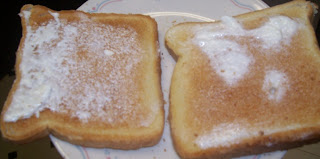Ingredients:
- One Pint of heavy whipping cream, very cold
- 1 Mason jar or one of similar size
- 1-2 marbles
- lid for the jar
- 1/8 tsp. salt (optional)
- a couple of strong arms!
 Make sure the jar is clean and dry inside and out (you don't want the jar to slip from the hands!).
Make sure the jar is clean and dry inside and out (you don't want the jar to slip from the hands!). Pour the cold heavy whipping cream into the jar.
Place marbles in the jar and secure the lid tightly.
Take turns shaking the jar until the solid butter forms.
It will take about 15-20 minutes.
Make sure to open it and look at the various stages of the developing butter to see the changes it is going through. As the butter begins to form, it will begin to clump more and more. The butter will begin to separate from the liquid (buttermilk).
In the next phase, you will actually see the creamy whipping cream begin to form. Keep shaking! You are almost there.
 When you can no longer hear the marbles being bumped around, open the jar and place the butter clump into a dish. Sprinkle the top of the butter with 1/8 teaspoon of salt (optional) and begin working it with your fingers until all the liquid is worked out. The picture you see at the right is the finished butter after the buttermilk (below) has been pressed out.
When you can no longer hear the marbles being bumped around, open the jar and place the butter clump into a dish. Sprinkle the top of the butter with 1/8 teaspoon of salt (optional) and begin working it with your fingers until all the liquid is worked out. The picture you see at the right is the finished butter after the buttermilk (below) has been pressed out. You have to make sure the liquid is worked out of the butter or it will cause it to spoil more quickly.
You have to make sure the liquid is worked out of the butter or it will cause it to spoil more quickly. Place it on a clean plate and form it as desired. You can even use a butter mold or a mold of some sort to give it some design! Store your finished product in the refrigerator.
Tip: Do not use a Ragu spaghetti sauce jar. We tried this time and the marble broke the jar. However, we have used a Mason jar successfully. This time we ended up using a Tupperware container after our jar broke...you do have to make sure to hold the lid on the container though because it is not screwed down and wants to "bump" off.
Some ways to use this "lesson":
- You can study about animals and how they give us food. (younger children)
- This is a great experiment to demonstrate changes in matter - liquid to a solid. They can make predictions as to what they think will happen. They can then figure out why and how the change happens. You can also re-melt the butter and put the liquid back in and it is changed back into cream again - solid to liquid.
- This is an example of a physical change in matter. You can use this in a lesson comparing physical and chemical changes.
- Work through the Scientific Process/Method: ask a question, research the question, develop a hypothesis, test the hypothesis by conducting an experiment, analyze/ study your data, and state your conclusions.
- You can also use this for a history lesson and discuss churning butter or pioneer life. It can be a part of a study on milk, dairy farms, etc..
As you can see, there are endless possibilities where you can use this experiment. Or, you can just use it to have fun (which is what we did this time). You can latch on to teachable moments during the experiment and allow your child to learn through experience and interaction with you. Most importantly - have fun!










1 comment:
This looks like fun! You are such a good teacher.
Post a Comment